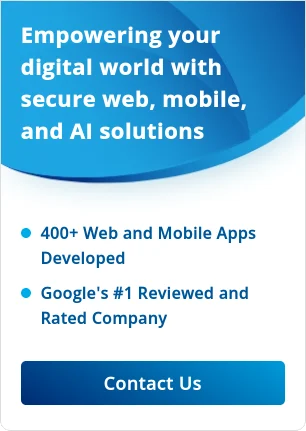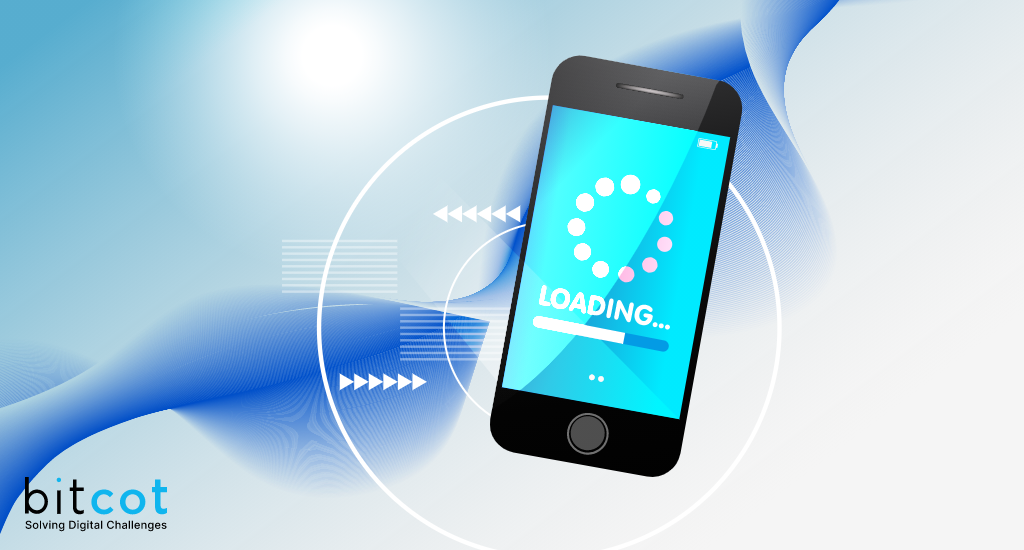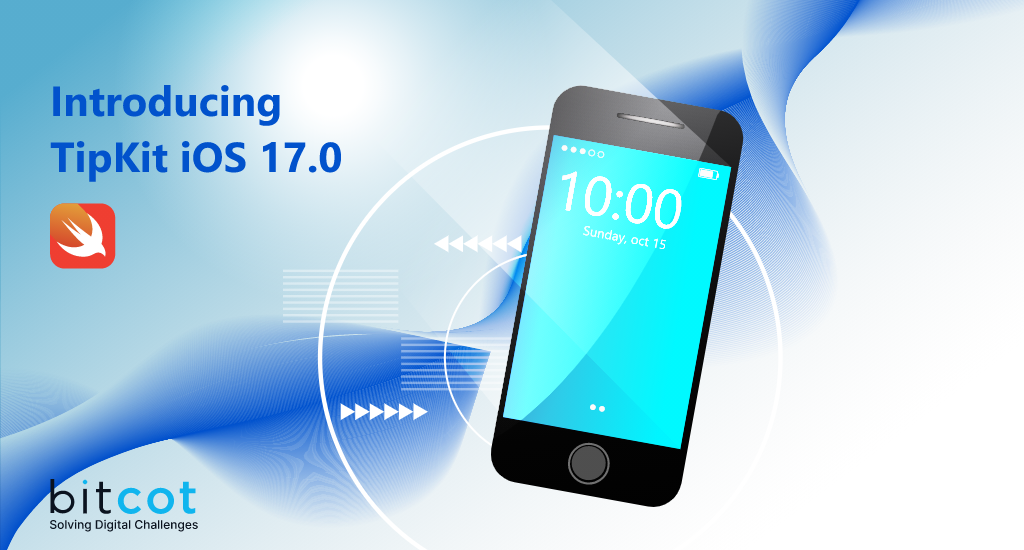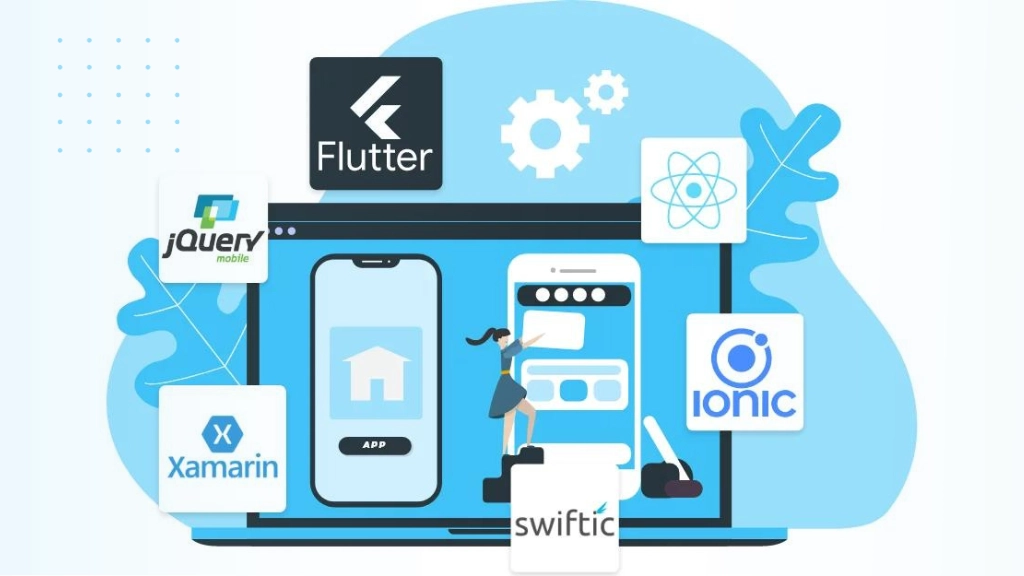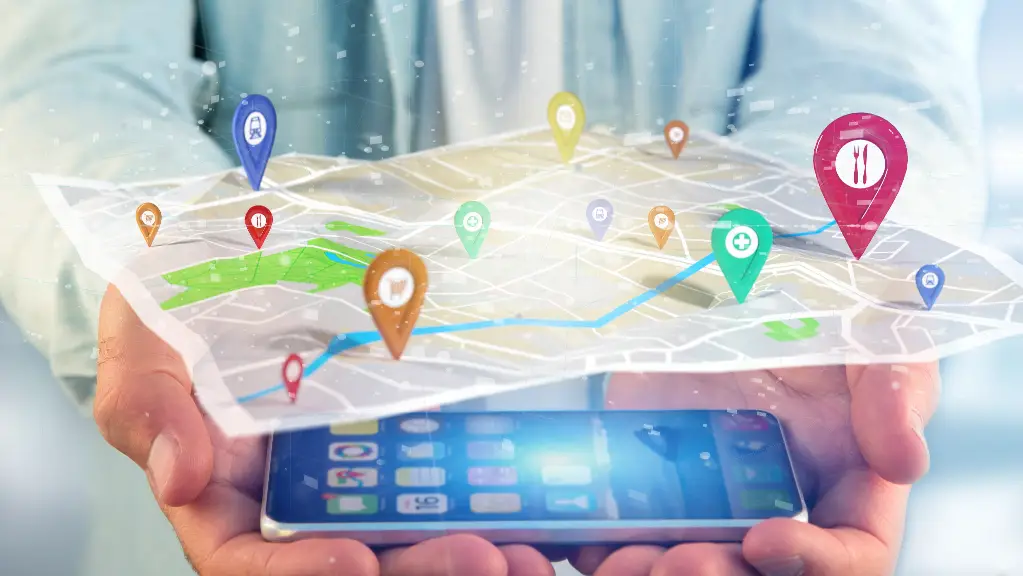
In an ever-evolving mobile application landscape, geofencing has emerged as an essential tool for businesses, developers, and individuals alike. But what exactly is geofencing, and why is it so important?
Geofencing is a technology that defines a virtual boundary around a real-world geographical area. In the context of a mobile application, it allows the app to react to the user crossing this boundary. In other words, when a device enters, exits, or lingers in a predefined geofence, the application can trigger specific actions or notifications.
The importance of geofencing lies in its ability to bridge the gap between the digital and physical worlds. It allows businesses to engage with users based on their location in a highly contextual and personalized manner, which can drive customer engagement and offer valuable insights into user behavior.
Technical Workings of Geofencing in iOS
The implementation of geofencing varies across different platforms, but in iOS, it is facilitated by the CoreLocation framework. This framework provides classes and protocols to configure and schedule location delivery and to receive location updates.
When a geofence is set up, the CoreLocation framework begins to monitor the specified area. As the user’s location changes (updated periodically by the system), the framework compares the new location with the geofence boundaries. If the user crosses the geofence boundary, the system notifies the app, which can then respond appropriately.
Deep Dive into CoreLocation Framework
The CoreLocation framework is central to geofencing in iOS. It provides the necessary tools to report and monitor the device’s current location, allowing your application to adapt to changes in that location.
The CLLocationManager class is the heart of this framework. It provides services for handling location, heading (device orientation), and region monitoring (geofencing). When it comes to geofencing, the startMonitoring(for:) method is used to start the delivery of notifications for a specific region.
Setting Up Geofencing in an iOS App Using Swift
Let’s take a closer look at how to set up geofencing in an iOS app using Swift.
Creating a Custom Geofence Class
First, let’s create a custom Geofence class. This class will contain the location, radius, and identifier for each geofence.
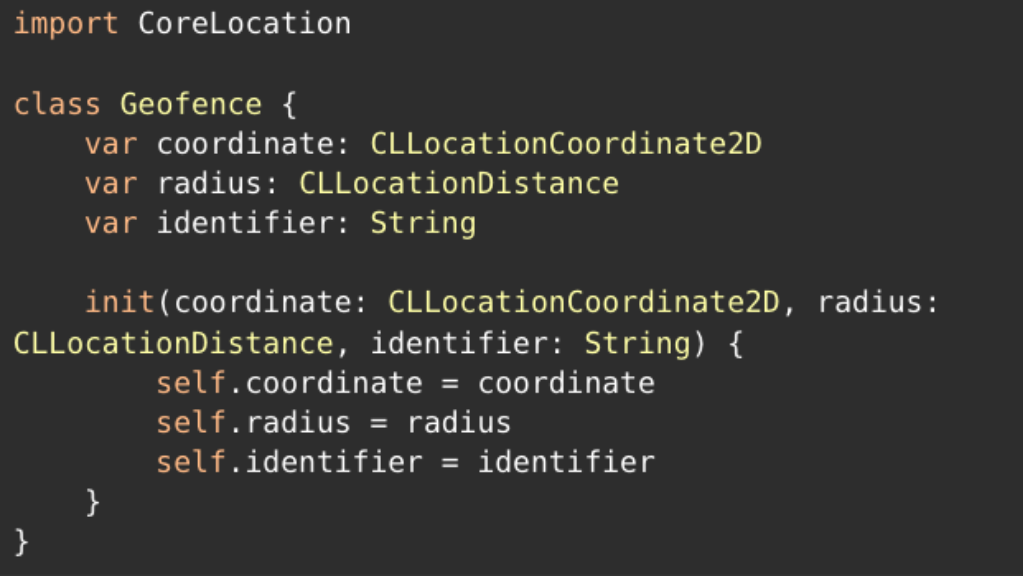
Handling Location Permissions
Next, we need to handle location permissions. It’s critical to ensure your app has the necessary permissions to access the user’s location.

Core Location framework, requestAlwaysAuthorization is a method used to ask users for permission to access their device’s location data at all times, even when the app is not active.
When an app uses this method, the user will see a permission prompt asking whether they want to grant the app permission to access their location at all times. This is commonly used for apps that provide location-based services, navigation, geofencing, or other functionalities that require continuous access to the user’s location.
Requesting Necessary Permissions
Add the following keys to your app’s Info.plist:
NSLocationAlwaysUsageDescription: Message displayed when requesting location access at all times.
Setting up Geofences using CLCircularRegion:
1. Create a Region
2. Create a CLCircularRegion

3. Set the region to notify on entry and/or exit:

4. Start monitoring:
![]()
5. Implementing Delegate Methods:
Conform to CLLocationManagerDelegate and implement the methods:
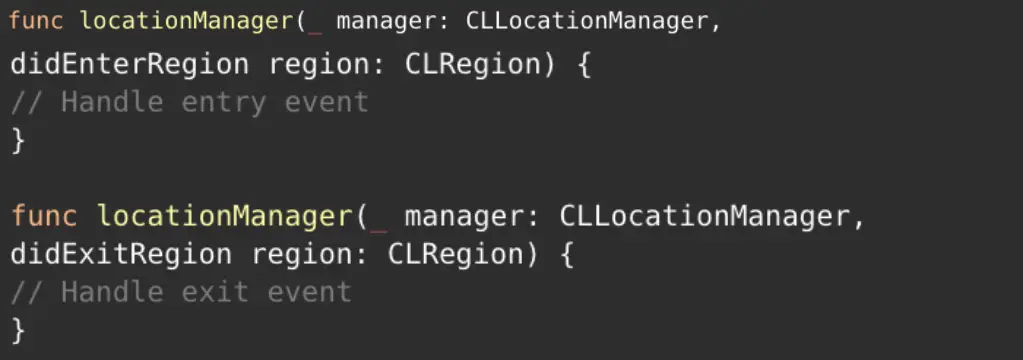
6. Background Location Updates:
- Go to your app target settings in Xcode.
- Navigate to the “Capabilities” tab.
- Turn on “Background Modes” and check “Location updates”.
7. Local Notifications for Geofence Events:
- Add the UserNotifications framework.
- Request permission:

- Craft a notification when a geofence event is triggered:
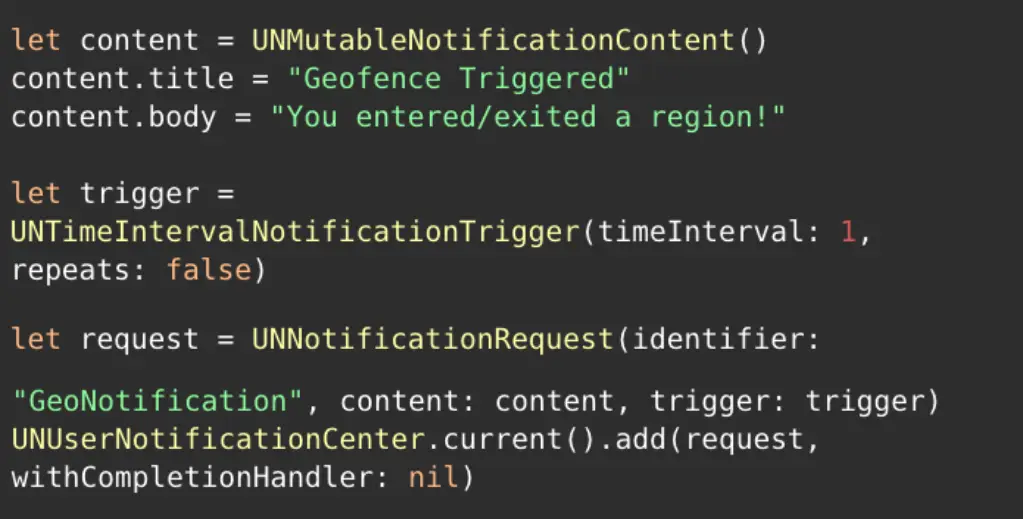
8. Responding to Geofence Events
Finally, we need to respond to geofence events. This involves setting up the necessary delegate methods to handle when the user enters or exits a geofence.
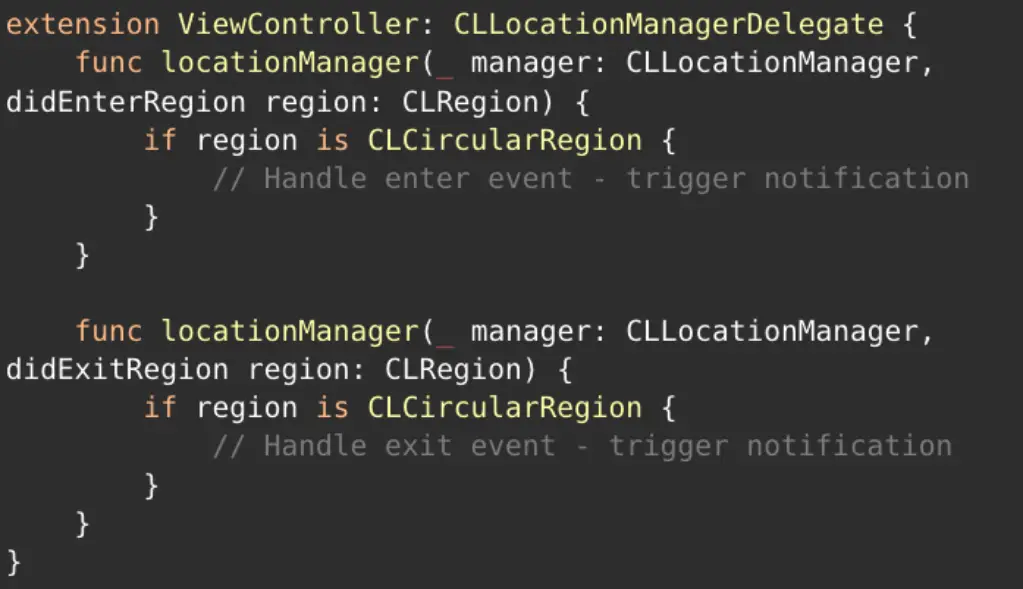
Real-World Applications and Case Studies
Retail and Marketing:
- Personalized Promotions: Retailers can set up geofences around their stores. When a customer enters this area, they can receive personalized promotions or discounts via a mobile app.
- Case Study: Starbucks uses geofencing to send push notifications to users when they are near a Starbucks outlet, offering them special deals or reminding them of their favorite order.
Transportation and Logistics:
- Fleet Management: Companies can use geofencing to monitor their fleet of vehicles, ensuring they stick to their routes and alerting managers if a vehicle goes off-course.
- Case Study: Uber uses geofencing at popular locations like airports to organize drivers into virtual queues, ensuring a streamlined pickup process for passengers.
Real Estate:
- Virtual Property Tours: Potential buyers can receive notifications about open houses or virtual tours when they are near a property that matches their preferences.
- Case Study: A real estate company in San Francisco set up geofences around its premium properties. Interested buyers received VR headset-based virtual tours as soon as they entered the geofenced area.
Agriculture:
- Crop Monitoring: Farmers can set up geofences around specific plots of land. If a piece of machinery or livestock enters or exits this area, they receive a notification.
- Case Study: A farm in Nebraska used geofencing to monitor the movement of its cattle, ensuring they didn’t wander into crop-growing areas.
Event Management:
- Attendee Engagement: At large events or conferences, organizers can use geofencing to send attendees information about sessions, stalls, or offers based on their location.
- Case Study: At CES 2020, exhibitors used geofencing to send attendees special offers or product demos as they approached their stalls.
Smart Cities:
- Traffic Management: Cities can set up geofences in congested areas. When traffic increases in these zones, the city’s traffic management system can adjust traffic lights or send alerts to drivers.
- Case Study: In Stockholm, the city implemented geofencing to manage and reduce traffic congestion in its central areas, leading to smoother traffic flow and reduced emissions.
Healthcare:
- Patient Monitoring: Hospitals can use geofencing to monitor patients with dementia or other conditions, ensuring they don’t wander off.
- Case Study: A hospital in Toronto set up geofences around its premises. If a patient with a history of wandering tried to leave, the staff received instant notifications.
Conclusion
Geofencing is a powerful technology with immense potential. As the world continues to digitize, the line between digital and physical interactions will become increasingly blurred. Geofencing will play a critical role in this transition, offering new ways to engage users based on their location.
However, as with any technology, geofencing comes with its challenges, including privacy concerns and battery usage. It’s crucial for developers to consider these factors and be transparent with users about how their data is being used.
Further Learning Resources
Ready to dive deeper into geofencing in iOS? Here are some excellent resources:
Books:
- “iOS Programming: The Big Nerd Ranch Guide” by Christian Keur and Aaron Hillegass
- “Mastering iOS 12 Programming” by Donny Wals
Online Tutorials:
- Ray Wenderlich’s tutorials on CoreLocation and Geofencing
- Apple’s official CoreLocation documentation
Video Material:
- Stanford University’s course on Developing iOS Apps
Happy coding, and we look forward to seeing the innovative ways you’ll use geofencing in your iOS applications!
